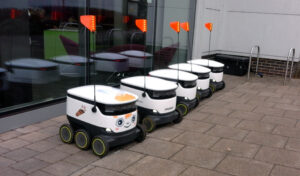No longer artefacts of science fiction, artificially intelligences (AIs) are becoming increasingly embedded in our towns and cities. Urban AI can now be found in transport systems such as in robots for grocery delivery and connected autonomous vehicles more generally, as well as in city governance, planning and design practices in the form of so-called digital twins. Indeed, cities of multiple intelligences which include artificial ones have arrived.

Cities are subject to successive waves of socio-technical innovation. In Western countries notable 20thCentury examples include electrification of cities and the mass adoption of automobiles. More recently, sensor networks and big data hubs have been established in many cities under the auspices of ‘smart city’ developments which aim to augment city management. While quite diverse in nature, a common feature of smart city developments is the datafication of extant city infrastructures, systems and practices. The logic in play here is to increase our knowledge of the functioning of such urban artifacts which underpin everyday lives in cities and then somehow optimise their performance. Such developments are therefore often deemed technocratic and use 21st century technologies to perpetuate 20th century modernist ideals of efficacy and efficiency embodied in machinic perspectives on cities.
There is little doubt that urban AI and associated mechatronics and systems are the latest wave of socio-technical change to hit cities. In order to perform AIs have to learn and they have a voracious appetite for data and thus the so-called big data collected in smart city initiatives are useful feeding grounds. Although it is tempting to think that AI is the next step in a data based socio-technical trajectory embodied in smart city initiatives, we argue AIs are quite different to smart city developments and raise particular challenges requiring new conceptual apparatus, as well as governance and management responses.
First, smart city developments provide data to human governance actors for decision support purposes. In contrast AI based technologies draw upon all manner of data to learn, make decisions and act – under human supervision or otherwise. Thus AIs are new urban actors who cannot be ignored as without human oversight they may restructure the already technicised relations which constitute the urban and release new potentialities.
Second, these new urban actors AIs think and act in profoundly different ways to humans. On one hand the ability of AIs to think and act differently may offer considerable utility in achieving the kinds of deep structural transformations which are likely to be required to meet the challenges of climate change. For example, there is little doubt that 20th century thinking and practices associated with automobility need to be challenged and changed. On the other hand, AIs ability to think differently and act autonomously may lead to futures in which it is difficult for humans to relate to AIs and lead to concerns that they may eventually exceed human governance and management capacities. Although such concerns may be exaggerated, there is clearly a need to ensure humans and cities can resist AIs and halt their development and actions as they think fit.
Conceptual apparatus to govern urban AIs is therefore desperately needed, to realise the benefits of urban AI in attaining more sustainable cities and to avoid deleterious urban futures. However, we cannot simply open the ‘black box’ of urban AIs to greater scrutiny as we are unable to comprehend how they think. This means we have to accept that the intentions and actions of urban AIs will always be somewhat opaque to human actors. Here conceptual apparatus for governance and management purposes may not be found in focusing on the functioning of urban AIs but in the interfaces associated with them, most importantly human-machine ones. Such approaches chime well with relational geography, which emphasises the role of relations, their intersections, and potentialities in the constitution of space. While there is little doubt that such spatial relations are developed in contingent fashion meaning there is little capacity to control their development, there is a capacity to act and govern urban AIs. Here insights from relational geography and design, perhaps with science and technology studies forming a common theoretical base, might be usefully drawn upon to create requisite conceptual apparatus for the governance of Urban AI.
Matthew Cook and Miguel Valdez

Leave a Reply